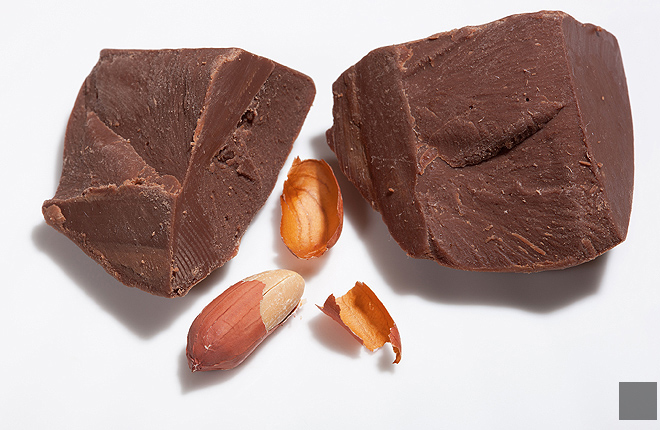Value-Added Use for Peanut Skins
Dark chocolate is touted for its higher levels of plant-based cocoa bean than milk chocolate, but that does not mean chocolate lovers enjoy milk chocolate any less. Love of milk chocolate is mostly about the yummy taste from added fats, sugars, and creams versus dark chocolate's higher levels of defatted cocoa powder known as cacao.
Now, ARS researchers in Raleigh, North Carolina, have reported that consumers can enjoy the taste of milk chocolate that contains similar levels of plant compounds known as "polyphenols" as found in dark chocolate.
For the new study, ARS researchers increased the levels of phenolic compound in milk chocolate to levels equivalent to those of dark chocolate without negatively affecting the flavor. They achieved the boost by adding an ingredient extracted from something usually considered as waste-peanut skins.
Plants protect themselves against stressors by forming chemical compounds that include polyphenols. Both cocoa and peanut skins are rich in polyphenols—although it is unknown at this time if polyphenols from peanut skins and cocoa are equally bioaccessible (meaning in ability to release from food) or equally bioavailable (meaning for use by a consumer).
Peanut processing removes thousands of tons of peanut skins each year, which are generally considered little more than a waste-management problem. The ARS scientists developed a process to turn peanut-skin extract into a powder that can be used as a food ingredient. Food technologist Lisa Dean, with the ARS Market Quality and Handling Research Unit in Raleigh, North Carolina, headed the study. Co-authors include Brianna Hess and Claire Klevorn, both with North Carolina State University in Raleigh. The team extracted peanut-skin polyphenolics and treated them for use as an ingredient in a variety of foods, including chocolate.
When added to milk chocolate, the peanut-skin powder increased the levels of polyphenols in milk chocolate to those of dark chocolate without making it bitter. This is important because evidence indicates phenolics may impart a bitter taste, and theoretically, plants with relatively high levels of phenolics can potentially taste the most bitter. "We used food-grade maltodextrin, which is a sugar compound, to create the powder, which decreases the bitter taste of the food ingredient," says Dean. Volunteers who sampled a milk chocolate optimally enriched with the peanut-skin powder and a "regular" milk chocolate did not have a preference.
"While we have studied bioactivity of the extract in cell-culture and test-tube studies, more research is required to gauge whether there is a measureable benefit from consuming foods enriched with this extract," says Dean. "Allergenic effects of the extracts would have to be thoroughly evaluated before inclusion in any foods, and labeling would have to emphasize the addition of peanut products."
The study appeared in the November 2016 issue of The Journal of Food Science. — By Rosalie Marion Bliss, formerly with the ARS Office of Communications.
Key Facts
- Peanut skins are a processing waste product.
- Peanut skins are rich in plant compounds called polyphenols.
- ARS scientists made a food ingredient from peanut skins.
- The ingredient increased polyphenol levels in milk chocolate without affecting flavor.
Full Story







